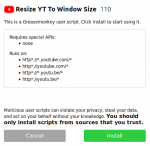Greasemonkey Manual:Installing Scripts
 Greasemonkey Manual |
| Using Greasemonkey |
|---|
| Installing Scripts |
| Monkey Menu |
| Getting Help |
| User Script Authoring |
| Editing |
| Environment |
| API |
About User Scripts
The purpose of Greasemonkey is to manage user scripts. User scripts allow the user to control the way they use the web, by customizing it with scripting. The Greasemonkey extension won't do any good without any scripts installed.
The first thing an eager user should do is find and install (or write
The Installation Dialog
When navigating to a user script, Greasemonkey will open its installation dialog instead of loading the script like a normal page. A thumbnail of this dialog is shown to the left. It displays the name and description of the script, if available, as well as the include and exclude rules that apply. Note: Greasemonkey must be enabled to install scripts.

- The Install button
This button will, of course, install the script in question. Like the Firefox extension installation dialog, this button is disabled for a few seconds to avoid the same potential security vulnerability.
- The Cancel button
This button will cancel the installation of a script.
- The View Script Source button
This button will allow viewing of the source code contained in the script. At this point, Greasemonkey has already downloaded the user script in question to display the name and other details.
When a user shows the script source, it displays the temporary file that Greasemonkey has already downloaded depicted in this screenshot. In this window there is an information bar at the top similar to the Firefox extension installation security warning. Clicking the install button here will also install the script.
With some scripts installed, Script Management is the next step.